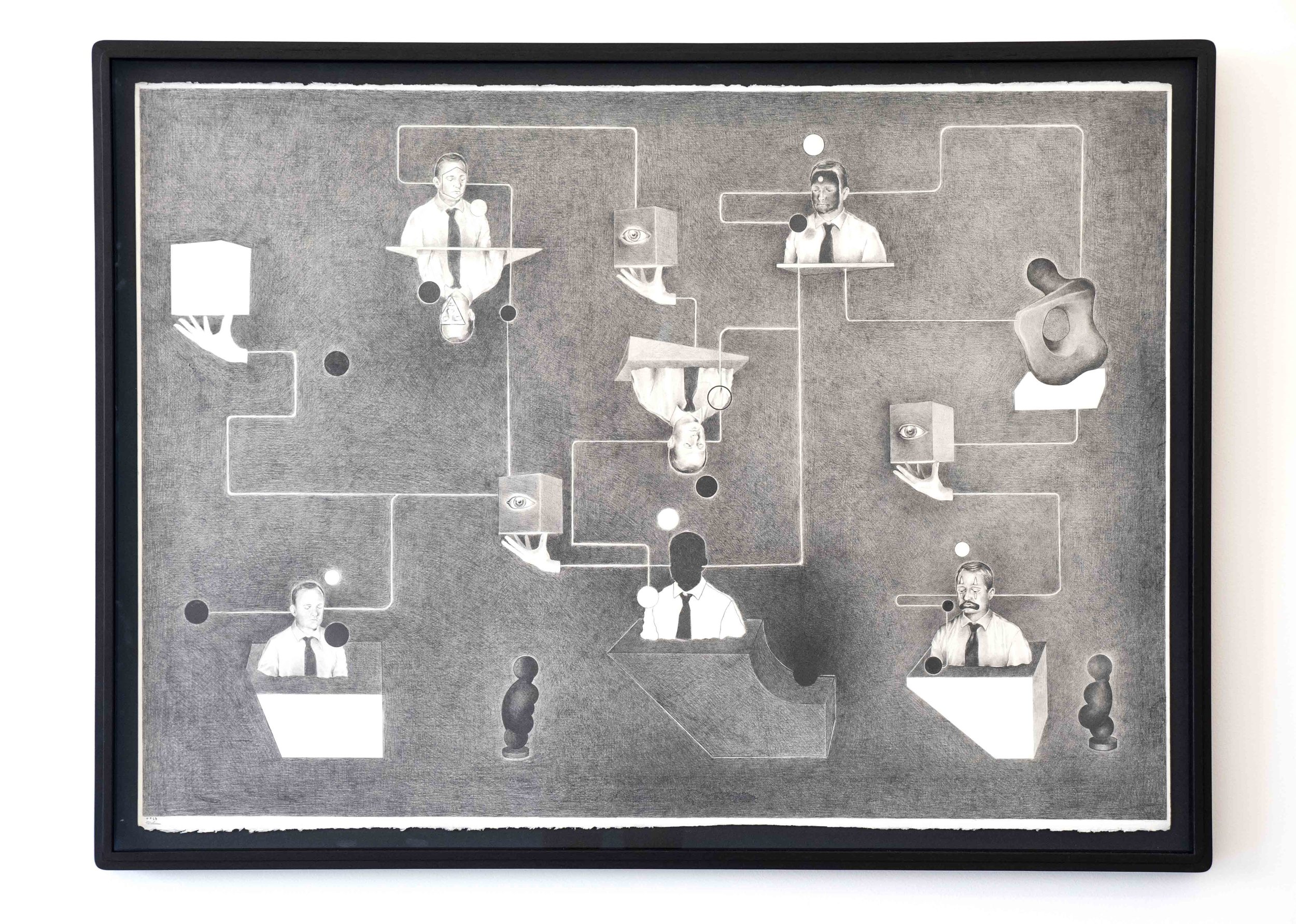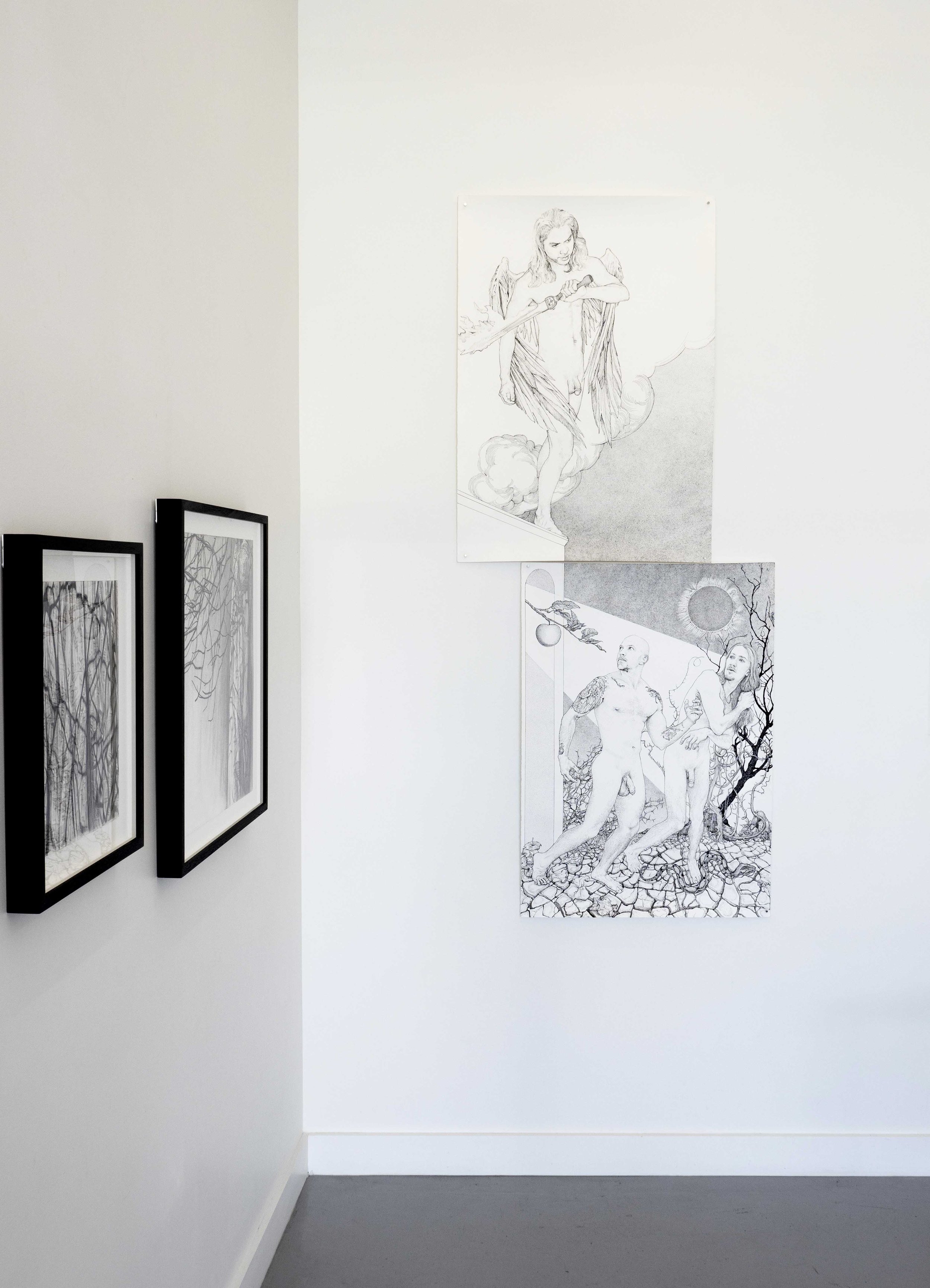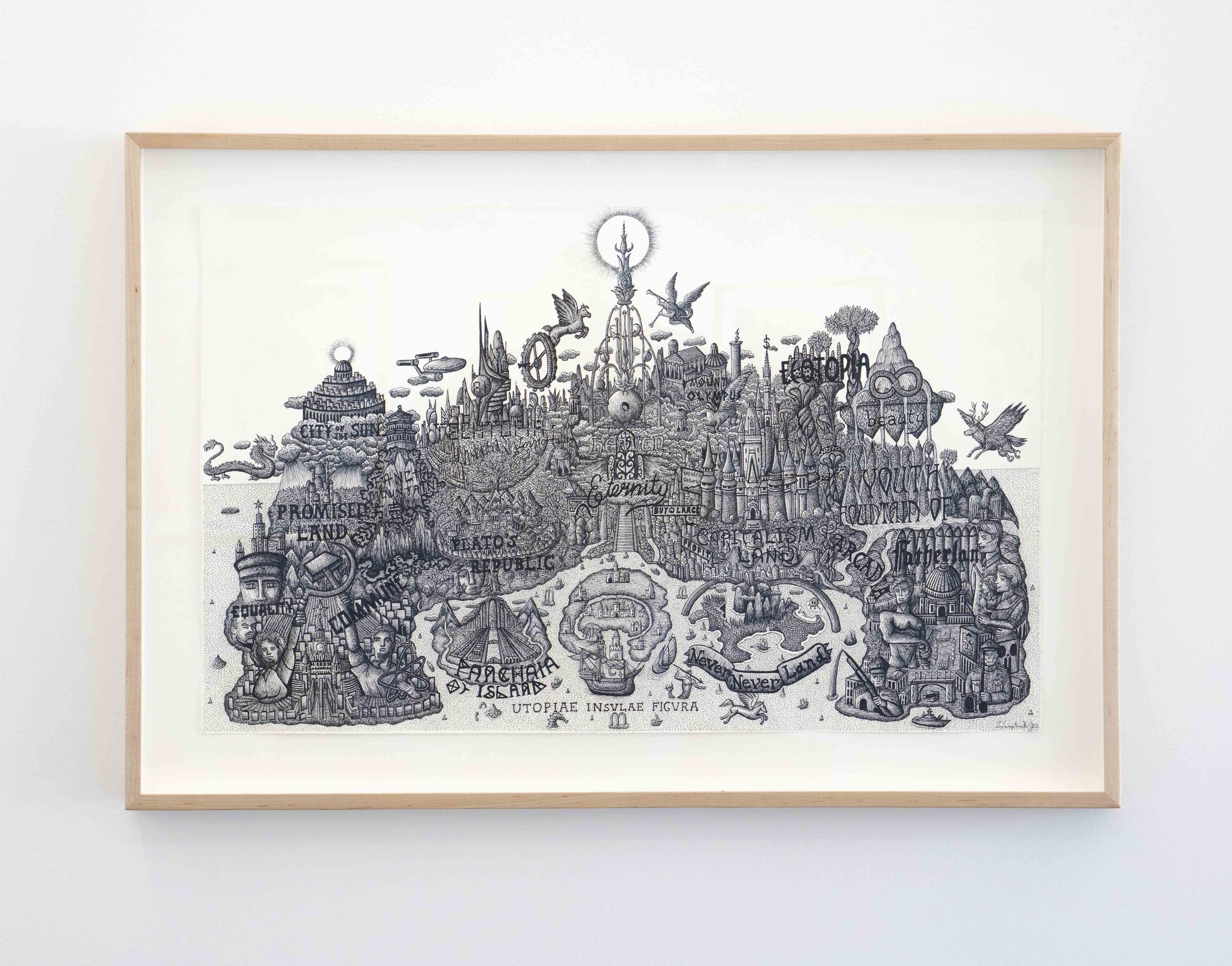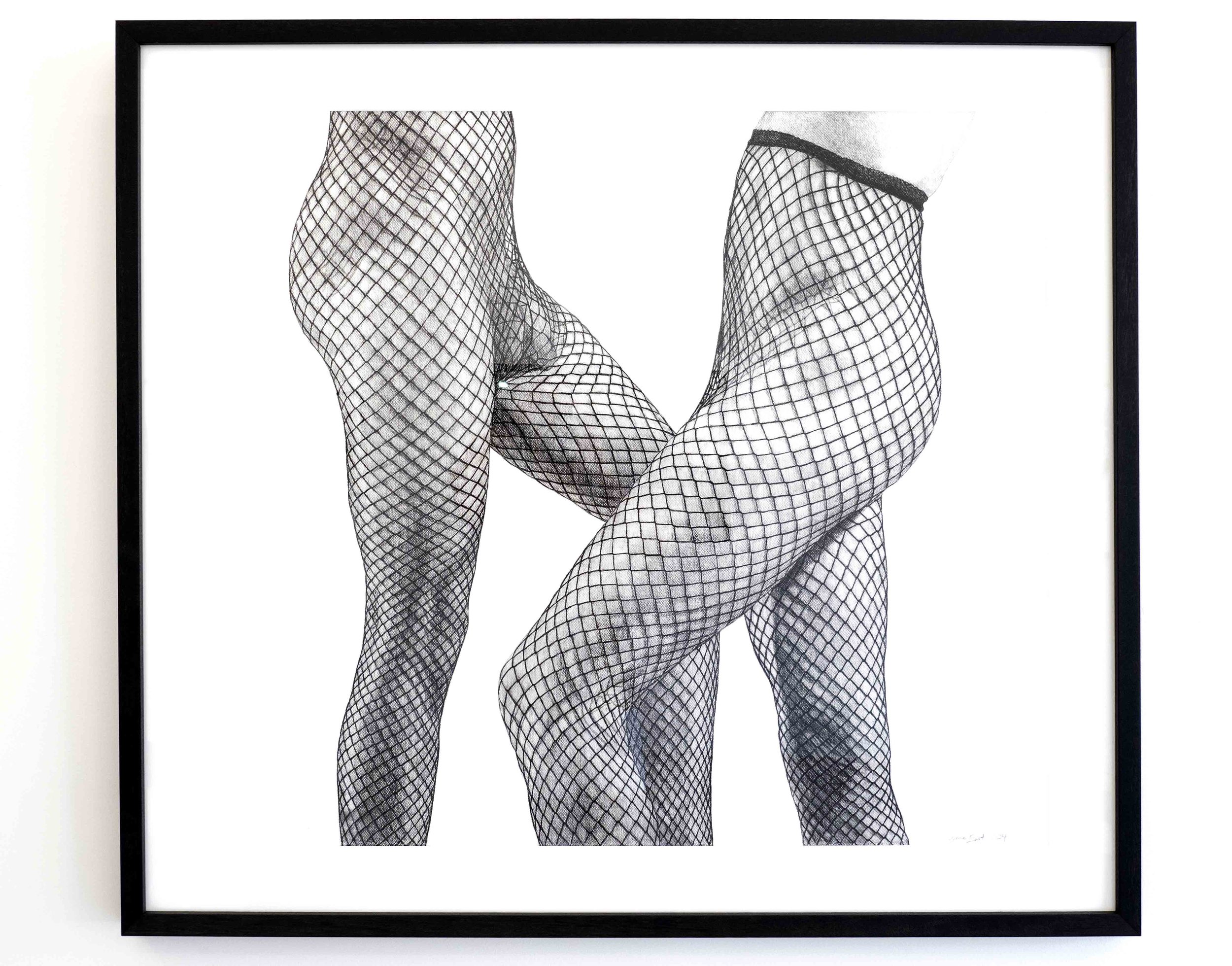Group Show / DETAIL
6pm Thursday 7 March to 5pm Sunday 31 March 2024
Curated by Jeremy Smith
DRAW Space are delighted to present the work of twelve artists in Group Show / DETAIL.
Drawing can be described as an activity as much as a medium. The act of drawing is often valued for its characteristics of directness, quickness, simplicity, abbreviation, and immediacy. However, the act of drawing can also be valued for the opposite characteristics, as labour intensive work requiring time and considerable attention to detail.
The exhibition DETAIL seeks to showcase the complex and intricate world of detailed drawings, focusing on time, labour and beauty. The exhibition will aim to answer such questions as why certain artists feel compelled to use detail in their practices, how they manage the physicality and sustainability of time and labour intensive practices, and how, ultimately, does detail in drawing create meaning?
The exhibition will present a diverse collection of drawings from twelve established and emerging artists, representing different styles, techniques and subject matter. DETAIL will encourage viewers to contemplate, both experientially and conceptually, the often overlooked subtleties of detail in drawing, its capacity for visual storytelling and the mastery of drawing techniques needed to capture minute detail.
The exhibition will feature the work of Kim Anderson, Jack Buckley, Artemisia Cornett, Yvonne East, Todd Fuller, Andrew Nicholls, Eva Nolan, Catherine O’Donnell, Jeremy Smith, Jack Stahel, Susumu Takashima and Teo Treloar.















Jeremy Smith and Todd Fuller are represented by .M Contemporary.
Eva Nolan and Teo Treloar are represented by Olsen Gallery.
Kim Anderson is represented by Flinders Lane Gallery and Penny Contemporary.
Catherine O’Donnell is represented by Dominik Mersch Gallery.
Susumu Takashima is represented by Gallery Kazuki and Gallery Moryta.
Room Sheet
Click on the image on the left to download the Group Show / DETAIL roomsheet.
Contact DRAW Space for purchases. Email info@drawspace.org.
EXHIBITION ESSAY – Eternity in an hour by Jeremy Smith
‘Eternity in an hour’
‘To see a World in a Grain of Sand,
And a Heaven in a Wild Flower
Hold Infinity in the palm of your hand
And Eternity in an hour.’
-William Blake, 'Auguries of Innocence’
When pondering detail in drawing, the opening lines from, one of my favourite poems, ‘Auguries of Innocence’ by William Blake whispers in my mind. To me, these profound words by the poet and artist encapsulate the essence of what it is to be a detailed drawer.
To be a detailed drawer, to see and know a subject not only as it appears but to see what it can be, to see ‘a world in a grain of sand’. Beyond merely the meticulous rendering of lines and shapes, each stroke of the pen or pencil becomes an invitation to zoom into a world of its own. Detailed drawings become worlds within worlds. Just as a grain of sand contains multitudes of tiny particles, so too does a detailed drawing contain a universe of complexity waiting to be explored. It is often the smallest details that hold the greatest significance. Detailed artists combine hypervigilance with expansive imagination. Every small drawn mark builds to a world of each artist’s unique perception.
To be a detailed drawer is to master the ability to transcend the ordinary and perceive the extraordinary within the mundane, to see ‘heaven in a wild flower’. So often in life we look but we don’t see. For detailed drawers, even the most humble and unassuming subjects can become objects of transcendent beauty. Just as with the delicate petals of a wildflower, we discover a microcosm of a universe teeming with life, colour, and complexity. Many detailed artists in this exhibition use detail to delve into the artistry of the natural world, capturing the ethereal essence of bird feathers, the veins of a tree branch, or the delicate dance of a butterfly on a breeze. In the realm of detailed drawing any subject, truly seen, becomes a thing of wonder.
And finally, to be a detailed drawer is to be a master of time, to ‘hold infinity in the palm of your hand and eternity in an hour’. This exhibition collectively represents the labour of hundreds of hours of drawing. Time for detailed drawers is truly relative. To entirely immerse oneself into a many-hours-long drawing session is to have time slip away, a single moment stretches out into eternity. Many artists describe this state of timelessness as a flow state, in which past, present, and future merge into a single continuum. Within the quiet contemplation, discipline, patience, and dedication of detailed drawing, one discovers the timeless beauty of the present moment. This flow state offers a fleeting glimpse of eternity captured in a beyond-time dance of one drawn mark followed by another.
Each artist in DETAIL is a master of creating worlds, seeing the beauty in the everyday, and mastering time through dedication to labour-intensive drawing practices. As a detailed drawer myself, I curated the show I wanted to see. It is an exhibition that examines what it means to be a detailed drawer and celebrates the best of detailed drawing today. My curatorial philosophy was to curate the artists, rather than the work. Each artist selected was able to choose the drawing they wanted to exhibit. I selected the best detailed drawing artists I knew, ranging from established to emerging drawers, both national and international. More than half of the works in this exhibition are new works made for this exhibition. Each artist was asked to provide an explanation of what detail in their practice means to them:
‘To See a World in a Grain of Sand’
Some of my earliest memories are of me filling my sketchbooks with detailed cities, and intricately imagined worlds with myself in a top hat as an explorer of these exotic worlds. From childhood, detailed drawing has been a tool for both understanding the world around me and imagining my worlds. As a highly sensitive, anxious, and hyper-vigilant child, I felt I was always noticing details that others missed. In my practice today I draw detailed maps combining text, geography, psychology, narratives, symbols, and history on a large scale to create epistemologies. In Map of Utopias, I created an imagined island of all the major political and fictional utopias exploring the beauty and peril of utopian thinking. I map the idea that utopias can’t co-exist. One person’s utopia is another’s dystopia. In this merged world utopian thinking ignores human fragility and complexity. Ultimately the work calls for an end to the utopian promise of paradise, to instead focus on the here and now. Indeed, detailed drawing shows us the beauty of what is and the potential perils of utopian ‘what could be’.
Artemisia's detailed drawings require in-depth examination for at closer inspection her drawings are not what they appear to be at first glance. To enter the world of Artemisia’s detailed drawings is to see the beauty in the tension between clarity and ambiguity. She states, ‘detail provides an anchor to divine the unknown qualities of the pictorial plane, fostering believability to forms and spaces without requiring over-elaboration that devours the poetry of the subject’. Much like poetry, her detailed drawings both clarify and withhold prescriptive meaning, allowing the audience ‘space and guidance to weave their interpretation’. In What we can get…, and ...ameliorate (for a lover) this tension between clarity and ambiguity requires you to take your time in zooming into this world to find the hidden clues to its possible meaning. Artemisia, much like the poet Edgar Allan Poe, often employs hidden messages and symbolism in her works to convey deeper meanings and provoke thought. Through subtle clues, Artemisia invites the viewer to delve beneath the surface and uncover the dark truths that lurk within.
To enter the detailed drawings world of Teo Treloar is to enter the ‘inner workings of human behaviour’ carefully articulating its ‘temptations and corruptions’. This world is inhabited by ‘a select cast of characters’ in a Kafkaesque world of ‘repetition and duality’. This repeating cast of characters often in shirts and ties exist on psychological planes of detail representing ‘how thoughts can be processed and turned over in the mind’. The psychological nature of his drawings is reflected in his view of detail as a way to enact ‘mindfulness, and presence’, as ‘detail in and of itself requires concentration, and to exist in the moment’. In his detailed drawing The Tendency to do Nothing, While Still Doing Something, this reoccurring character’s thought patterns are mapped out as a kind of circuit board of interweaving psychological states. A mind map between light and dark, happiness and despair, figuration and abstraction, the masks we wear and lives we live in quiet white-collar desolation.
Jack Stahel not only sees a ‘world in a grain of sand’ but imagines the world through the lens of a non-human. Detailed drawing for Stahel is to enter a ‘different psychological state’, which allows him to not only explore and understand himself but offers a ‘time to escape’. For him, ‘detail is a way of extending that time, and facilitating getting lost in the process’. An experience described as a 'flow state’, a mental state in which a person is completely focused on a single task or activity. His practice has involved creating his own imaginary science together with the Museum of Imaginary Science (which you can visit on Instagram). In his drawing Introductory Educational Poster for Humans, he describes the drawing as a ‘homage to humans, from some of our more envious interstellar neighbours’. These envious neighbours describe humans as ‘famous across the galaxy for their special and innate ability to create’ and the poster offers education on the subject of these humans. It is one thing to create imagined worlds in drawing, Stahel goes one step further and imagines our world from the perspective of another world. With breathtaking detail of indecipherable language and inexplicable objects, travel to the very edge of imagination.
'And a Heaven in a Wild Flower’
Of all the artists in DETAIL perhaps none has achieved greater mastery of the ability to see the ‘heaven in a wildflower’ than Catherine O’Donnell. With a practice regarded by many as one of the most technically brilliant in Australia, O’Donnell has transformed the everyday, at times banal, architecture of modern Australia to the sacred and sublime. With subjects, buildings, and spaces often overlooked or dismissed as mundane, Catherine O’Donnell’s meticulously detailed drawings bring their hidden beauty to the forefront. As she states, ‘by immersing myself in the intricacies of the subjects I depict, I aim to reveal the humanity that exists within these spaces’. We look but we don’t see. Through this intense observational power Catherine O’Donnell ‘express not only what I see and feel’, but evokes in her viewer ‘a sense of curiosity and contemplation’. In Moyle House, the windows of an apartment block become a concrete canvas for O’Donnell to transform into a masterpiece of delicate beauty. She hints at the love found in the crease of a window blind in Beyond the curtain beats a loving heart. O’Donnell sees heaven in a fibro house and a concrete apartment block.
In an exhibition of detailed drawings, Eva Nolan’s work is the most detailed of all. Eva is the detailed drawers' detailed drawer. Nolan creates her impeccable drawings with the aid of a magnifying glass. She describes the time of ‘sustained absolute concentration’ required for her drawings as a form of meditation in which ‘everything else beyond the perimeter of the drawing slips away’. By intimately drawing ‘texture of a bird’s feathers, the fine lattice of a dragonfly’s wing, or the curve of a flower’s petal’ she develops ‘a way of being with the natural world that is care-based and attuned to the dynamic lives of our more-than-human companions.’ In both Tawny Frogmouth and Bottlebrush and King Parrot and Wandering Anemone, each intricate line and shade becomes a testament to the artistry of the natural world. Her drawings invite us to contemplate the interconnectedness of all living things and find solace in the simple elegance of nature. Beyond the confines of botanical drawing, Nolan’s work is full of love and imagination, dreaming of what could be, a world of harmony and equality.
Jack Buckley’s detailed drawings combine both the beauty of the natural world with the streets and places in Sydney he sees every day. He describes the drive for detail as an ‘obsessive desire to highlight the complexity of the forms represented’ in his drawings. Influenced by scientific and architectural styles which ‘emphasise a maximalist approach of capturing individual intricacies’, his drawings are investigations into the complexity of his subjects. His process of using ‘fine-point pen and the thinnest strands of embroidery thread’ results in works that are ‘permeable and intermingled expressions of the underlooked, featuring uncommon flora, unseen species, and architectural glimpses’. In Addison Road, Spotted Pardalote, Xanthorrhoea Fulva and Lennox Street, Yellow Robin, Banksia Serrata, Buckley captures not only the outward appearance of his surroundings but also the essence, the interconnectedness of all things, blending the urban and the natural in a seamless tapestry of life. Not only using pen drawing but also detail in embroidery.
Kim Anderson sees the heaven she sees in the natural landscape reflected in the internal world of our psychological states. She regards her practice as an exploration of our ‘complicated relationship with the natural world’. Navigating the ever-shifting boundaries between our inner and outer domains, often using elements of the external landscape as metaphors for intense psychological states. Her ‘painstaking, emotionally-laden drawings’ are based on 'photographs of herself immersed in isolated locations, undertaking solitary performances witnessed only by a remote-controlled camera’. She describes her drawing the finer details of my surroundings through ‘slow, meticulous mark-making’, counterbalances ‘our fast-paced, technology-driven culture, creating an experience that is meditative, introspective and quietly absorbing’. In her drawing In the Stillness 2, the silhouette of the branches of a tree mirrors the veins of her hand. Much like the windswept characters in Bronte’s Wuthering Heights, the external landscape reflects the tumultuous landscape of her own heart.
‘Hold Infinity in the palm of your hand
And Eternity in an hour.’
As the only animator in the exhibition, Todd Fuller’s drawings offer a unique perspective on the use of detail in animation, reflecting a mastery of time-intense drawing. For Fuller, the ‘thoroughness, an intense commitment to labour, and also to the act of observation’ inherent in detailed drawing, are also implicit in the process of animation. He describes his process as follows: ‘procedural detail is required as I ensure that every element in the space is consistent, considered, and ordered for a smooth workflow’. These details include the ‘lighting, furniture, markings on the floor for where I should stand’ to ‘ensure consistency in the animation process, allowing the illusion of animation to take place’. As Fuller describes, much of the detail needed for audiences to comprehend and imagine may only ‘be visible for a fraction of a second’. In his animation video Twelve, the hours of a clockface move around endlessly in an infinite loop. Much like the slippage of time during the flow state of drawing, time becomes relative. Some moments can last a lifetime and days that grind on, depending on our individual experience of time.
Andrew Nicholls' detailed drawing practice is linked to his Catholic upbringing, particularly ‘the discipline it demanded of me in relation to daily ritual, repetitive prayer, and penance’. Today as a ‘planetary magickal practitioner’, detailed drawing in his practice is a ‘tool for manifestation via the investment of time, focused attention and physical labour.’ The detailed childhood ritual combines with the adult labour to imbue his drawings as ‘acts of devotion to different spiritual entities’. This notion of his drawings as acts of devotion is evident in his epic drawing The Expulsion, a homoerotic retelling of a Biblical episode, in which Adam, Eve, and the Archangel Uriel are all cast as men. Nicholls casts his ‘male friends as the characters’ in the scene representing the fall of man from paradise. Nicholls’ time-intense drawing, often using repeated dot-making, mirrors the ritual of religion and its repetition linked with physical labour. Detailed drawing as an act of devotion, shows that through repetition one can ‘hold infinity in the palm of your hand’.
Yvonne East is a master of time-intensive drawing. As a painter, drawer and educator, East describes how she needs to teach her students how to perceive subjects for drawing with accuracy. She sees humans as having ‘the capacity for laser focus for refined detail that exists, alongside perception-blindness as we try to effectively navigate our way through a complex world’. It is this perception blindness, this inability to see things that she needs her students to unlearn. Detailed drawing for East is ‘an invitation to slow down, rest, and consider how we use and categorise details’. This ability to ‘see and know detail plays an important role in building narratives about ourselves and the people around us’. In her drawing Xavier, the legs of two bodies cross each other as they are criss-crossed by the netting of fishnet stockings. In her practice, East specialises in the intricate rendering of human anatomy. In her hands, the humble fishnet stocking becomes a work of art in its own right, its intricate patterns and delicate texture rendered with a precision and finesse that is breathtaking.
Japanese artist Susumu Takashima is a master of time and subtle detail in his mesmerisingly detailed abstract drawings. His works almost appear non-existent to the naked eye and require close inspection. Takashima states that the ‘main materials (tools) I use are brushes, coloured pencils, and metal point, which produce lines of varying thickness’. His lines are drawn with metal points, which are sharpened to a point, ‘start thin and gradually become thicker’. He states that ‘I try to give each piece its own depth and three-dimensionality by repeating these inherent changes in thickness’. In his works Arched Window (yin) and Arched Window (yang), his abstract metal point drawings onto paper create a masterly detailed terrain and textured landscape, each work opposing the other.
In conclusion, the exhibition DETAIL invites you to embark on a journey of discovery, a journey into the infinite realms of the minutiae. Through the lens of detailed drawing, you can see the world with fresh eyes, to uncover the hidden beauty that lies within the smallest of details. Through detailed drawing, you can experience Blake's timeless wisdom as you ‘hold infinity in the palm of our hand, and eternity in an hour’.
Jeremy Smith
© March 2024


